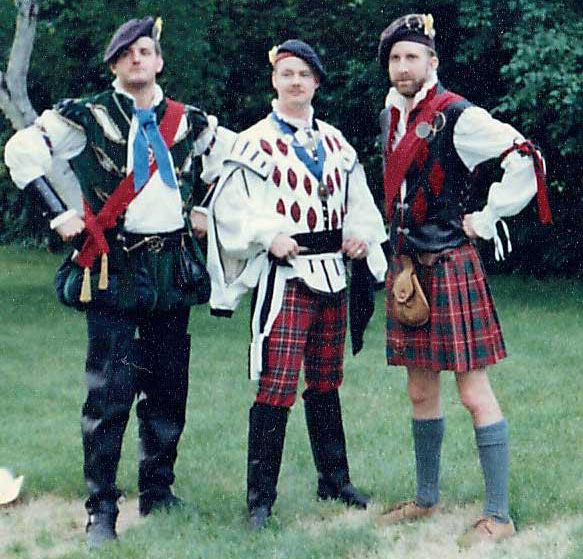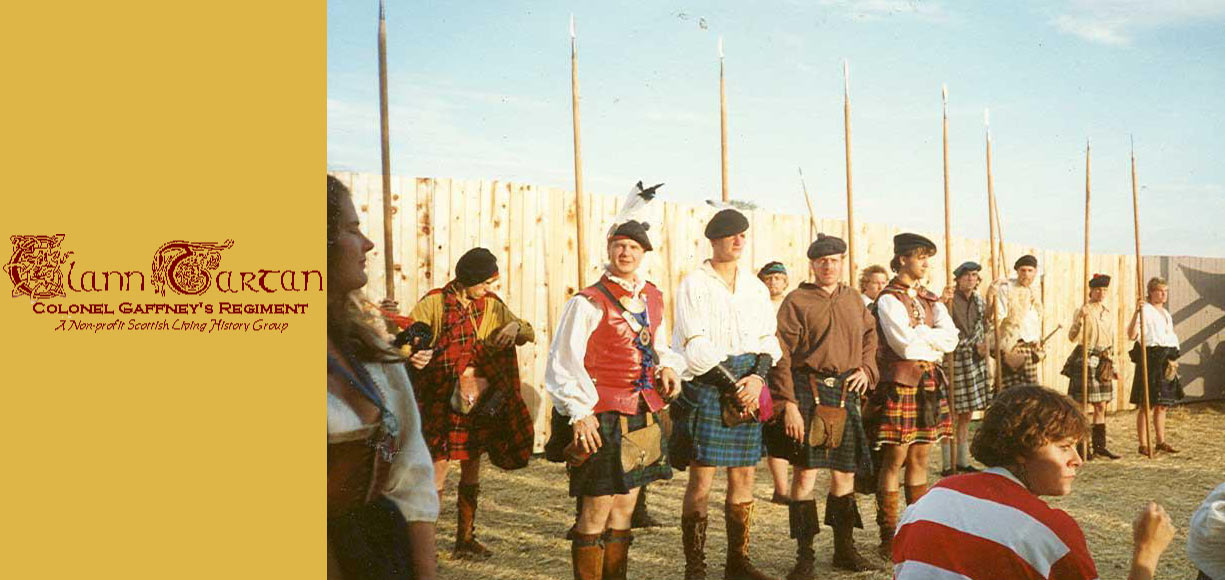Our History
If you have participated in historical re-enactment, or have worked in a "living history" context at historic sites, or in museums, you will immediately understand what is means to see the wonder, amazement, and interest inspired in those who witness your performances. For those who have been thusly inspired, this sense of the magical carries throughout the illusion and serves to further the illusion. Indeed, living history is a very real and powerful kind of magic which inspires us to know more of our past, but most importantly to share our knowledge, to teach it and pass it on to all generations. I have never been so inspired by anything else that I have done, and it matters not whether it be Elizabethan, Scottish, Irish, Civil War, Revolutionary War, Fur Trade, etc.
The passing of knowledge from one generation to the next is a sacred duty, and at a time when our learning institutions are failing to instill a proper interest in our past, what better alternative exists that has success at entertaining and teaching - providing enjoyment for both "teacher" and "pupil."
We have gradually placed less stress on presenting an "act" and instead devoted more attention to living history. A useful blend of both of the two can be found. We have gone far, and yet there is so much further to go. I cannot foresee the future of the group, but I do know that as long as we value true friendship, then we shall always be together.
How it started
The whole concept came about in a most indirect manner when Jeffrey Nordin and I met and discovered our mutual interest in history. Jeffrey and I had already accrued considerable experience with living history working with the Minnesota Historical Society at Historic Fort Snelling, which has an early 19th century military and frontier focus. He had also been associated with The First Minnesota, a Civil War Reenactment society. Though I had been avidly pursuing my studies in history at the College of St. Thomas, I had absolutely no exposure to the concept of living history. As I was keen on working at Fort Snelling, I viewed my chance meeting with Jeffrey (at an Irish bar known for its music) as a stroke of rare and (up to that point) scarce good luck. Little did I realize how fortunate I was in that fateful chance meeting. We discovered, to our delight, that we had much in common: our fondness for Celtic music, history in general and personalities which attracted each other.
The job at Fort Snelling came through and Jeffrey and I spent an enjoyable summer working together. I learned much from him that summer and my love for history continued to flourish through my extra-curricular studies at the Fort with Jeffrey. While at Fort Snelling, I had the good fortune of accompanying friends to a fur trade rendezvous at Prairie Du Chien for the fur trade and voyager reenactment group, La Compagnie. The only costume I could quickly throw together was a scant four and a half yard, belted plaid. I encountered other men at the rendezvous also wearing fhilidh biags and fhilidh mhors and immediately fell in with them for a roaring good time. That was the seed from which everything was to grow. Immediately Jeffrey and I fell to talking and planning. By the time of the rendezvous at Fort Snelling we had managed to arrange adequate costumes for Christine (Jeffrey's wife) and the two of us. There we met some young men from Fort Dauphine, Ontario, who were dressed as Scots fur traders and trappers. They seemed so interested, and we had so much fun, that Jeffrey and I continued to talk about getting a group together to do some Scottish living history. The time period had not yet solidified, but ranged from medieval to just before the defeat of the Highlanders at Culloden Moor in 1746.
That Autumn, Jeffrey, Christine and I paid a visit to the Minnesota Renaissance Festival to seek the lay of the land and to determine the feasibility of bringing a group out there to do living history, never mind that we didn't yet have a group! The good response we made proved a hearty encouragement and we determined to press on.
So, we put the word out to our friends who might be interested and, as we had hoped, there was a good response. By the time of the Macalester College Scottish Fair, we had managed to gather a small group of loyal and determined friends. We so impressed the people there that they asked us to lead the parade of Tartans. (By 1991, the Clann had grown so large that we were politely asked if we minded marching at the end of the parade!)
With Macalester Fair such a resounding success, we spent the next months preparing for the Renaissance Festival. The first year at festival brought mixed success. Though we failed to impress the management enough to garnish cash reparation, we were delighted by the new friends we had made and their delight at having us at the festival. Their confidence in us and appreciation of our efforts removed any concern we had about returning.
What really intrigued me, however, was the interest people expressed in our camp and their response to our interacting with them using the living history we had learned. We were such a hit that we were invited back for the next season as volunteers. We were determined that the management see us as worthy of a paid contract. We spent the next months improving the group, playing music and trying to find venues for the "act." We did the San Antonio Irish Festival for the cost of expenses and a cultural show in St. Peter, Minn. Both enjoyed astounding success with both establishments and crowds. The memories of the hospitality which was shown to us will always warm my heart. The Macalester Fair rolled around again and we made another appearance, with a significantly larger troupe and the addition of music for the entertainment of the visitors. Again we carried the flags and led the parade, and much to our amazement and delight we found that the cover of the program carried a full 8 x 10 photograph of the Clann leading the last year's parade. That was one of the finest compliments we had received. We had a grand time at the fair. By now, many of the clans were expressing interest in our group. Enheartened by those successes we began preparing for our second year at the festival. A few more had joined the group and some festival veterans had switched their allegiance to our group for the run of the festival.
So we went to work. We sewed together a tent, organized and planned, worked on our costumes, had two standards made, and practiced our music. By festival we were ready as could be. We settled on being Scots mercenaries, and to bolster this image we purchased a dozen ten-foot poles to practice pike drills. Funds were secured, and a weapons smith at the festival commissioned to construct a dozen pike heads (even though we could barely muster six pikemen!) Our strategy for this year was to so impress the management with what we could do that they would perceive our absence as a loss to the festival's entertainment. In the politics of festival, we hoped they would want us enough to pay us.
Our plan worked better than we hoped. We made a small presentation, only six men. But by the following weekend, people from festival were asking to join our group. They were instantly welcomed and were assisted in fashioning their costumes. Each weekend someone new joined our group and our following grew. Finally, by the end of the run we had a contingent of 12 pikemen, and assorted swordsmen, arquebusiers, crossbowmen and women to demonstrate crafts and domestic activities. Scotsmen abounded... in fact, they dominated the scene. Everyone seemed a bit taken aback by the numbers of our group. We ended the show feeling content with the success of our contribution to the festival. To date, we have many more events lined up, and we look forward to continued growth, choice of new venues and the general success of the Clann.
Summary
The question may remain in some minds, "Why Scottish life of the Renaissance?" Why not!?! Much of the original culture and way of life was destroyed by the English after the '45 Rebellion and the defeat at Culloden Moor. The ancient feudal clan system was dying a death hastened by the Succession Acts, Killings, and stern retributive prison sentences. This destroyed and forever lost various aspects of a culture and history. Much of what is commonly known as Scottish history and lore is actually Victorian fabrications and romantic sap encouraged by the likes of Sir Walter Scott, whose Gothic epics of the Highlands were written with the help of Lowland gentlemen. This was a class which has traditionally regarded the clansmen as barbaric savages. Tartans were created and ascribed to this clan or that as the old patterns had been lost with the passing of a generation. Religious devotion was and is now given to patterns that would not have been recognized by any clansman at Culloden. The English victory on that sad day forever changed the Highland way of life. As John Prebble so aptly phrased it in his superlative history entitled Culloden:
Once the chiefs lost their powers, many of them lost also any paternal interests in their clansmen. During the next hundred years they continued their wreck of Cumberland's battalions. Land which they had once held on behalf of their tribe now became theirs in fact and in law. They wore the tartan and kept a piper to play at their board, but profit and land-rents replaced a genuine pride in race. So that they might lease their glens and braes to the sheep farmers from the Lowlands and England, they cleared the crofts of men, women and children using police and soldiers where necessary. These descendents of those who had fought for their prince, or against him, were sent in thousands to Canada. It was a new Transportation, but this time the laird was responsible, not the government. From the green source of Glenaladah dipping down to the Loch Shiel, Alexander MacDonald had taken 150 men to serve in Clan Ranald's regiment. Within a century there was nothing but the lone shrilling of the song.
Indeed there was much that was lost. A culture was traumatized and its people abused. But they carried on - determined to make the best and not all that was good was lost. Many of the ethics of honor, family and friendship remained. The Celtic world abounded in good ways for living and we hope to show these values to the world and in this way let them know that people still care. Honor and virtue can still be seen as worthy qualities, and the family is not a thing of the past.
My sincere hope is that you should follow us in forming a Scottish mercenary company, and that you meet with some of the good fortune that we have enjoyed. The key, of course, is to truly appreciate your colleagues and friends while doing your enactment and those around you will pick up on it and feel the same. Imagine having Scots mercenary companies interspersed throughout the continent of North America. Sound the word and enjoy the pleasures it can bring!

